- Home Page
- Better Kites
- ... Delta Kite
How to Build a Delta Kite
Step by Step—Page 3 of 3
The MBK 2-Skewer Delta
How to Build a Delta Kite
Keel
Dacron line in 20- to 50-pound strength is suitable for all the Skewer Series kites.
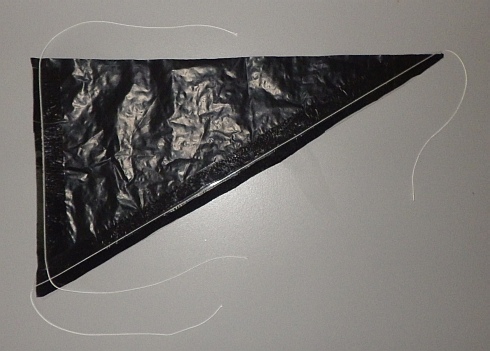
- Mark out a triangle on some spare plastic as per the dimensions on the template.
- Cut out the triangle, and tape down two lengths of flying line onto one side as in the photo. Use clear sticking tape.
- Now flip the plastic over, and tape down another two lengths of flying line directly over the first two.
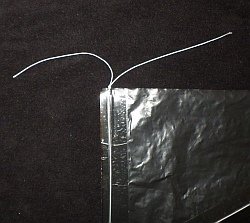
- Where two pieces of line cross the edge, carefully tie a Multi-Strand Simple knot. Position it so it touches (but does not crush) the keel plastic. See the photo.
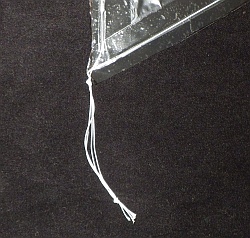
- Where the four pieces of line come together, tie a Multi-Strand Simple knot against the plastic as before, then tie another one further out as in the photo.
Here is the completed keel:
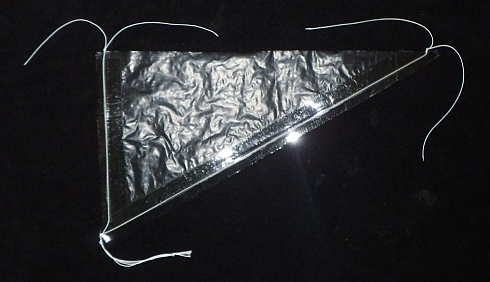
Now to attach the keel to the kite:

- Using a spare skewer, poke a hole in the plastic sail 0.85 SL (24.7 cm, 9 3/4 in.) from the nose of the kite and in line with the vertical spar.
- Thread the upper keel lines through this hole, and tie off tightly around the bamboo with a Granny knot.
- Using the keel itself to find the
exact spot, make another hole in the plastic for the lower lines. Thread them through, and tie off tightly as before. The photo shows both the Granny knots.
- With
the keel flat against the plastic sail, add sticking tape between the
knots, attaching the keel to the sail plastic. Then flip the keel over, and do the same on the other side.
At this point, you're nearly finished making the 2-Skewer Delta! It's a good idea to put a small drop of glue over the two Granny knots so they won't come undone or slide along the bamboo.
How to Build a Delta Kite
Reinforcing the Vertical Spar
If the spar is not reinforced, this kite can't be pushed too hard in not-so-light winds before it starts to flap. Adding the extra skewer doesn't cure this behavior completely, but it does extend the range of wind speeds in which the kite will fly smoothly.
The skewer is centered over where the vertical spar pieces are joined together then glued along its entire length. See the photo below, which shows the skewer glued to the back of the existing vertical spar. The extra bamboo is most easily seen near where the spreader goes across.
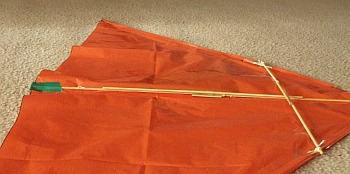
How to Build a Delta Kite
Prepare to Fly
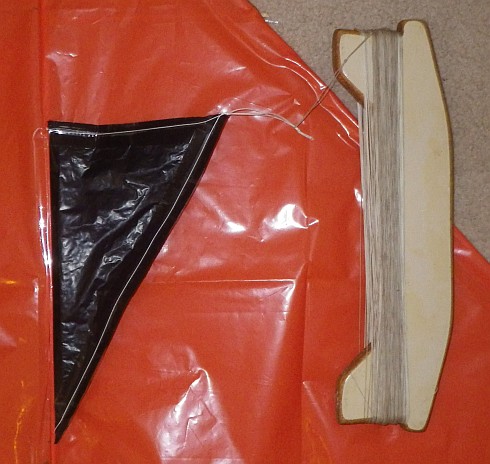
- Finally, make up a flying line, and attach it to the keel with a Lark's Head knot. See the photo above, which shows the Larks Head tightened against the second knot in the keel lines.
How to Build a Delta Kite
Flying!

Assuming there is some breeze outside, just dangle the kite at arm's length until the wind catches it. As long as you feel the kite pulling, let out line slowly by letting it slip through your fingers.
Out in the Field
Delta-kite stories of my real-life flying experiences are worth checking out!
Illustrated with photos and videos, of course.
Another way to launch is to get a helper to hold the kite up and let it go with maybe 15 or 20 meters (50 feet) of line let out. This way, the kite soon gets high enough to make it easy to let more line out. You could also try pulling it along the grass (with the keel on the bottom, of course) until the kite pops into the air and climbs away.
Up there is a picture of the MBK 2-Skewer Delta Mk2, merely a dot in the sky at 350 feet off the grass!
Have fun flying, and I hope you've enjoyed learning how to build a delta kite.
Now, just in case you have actually made and flown this kite at least once already:
Flight Reports From Other Visitors
Click below to read about various kite-flying adventures, contributed by other visitors to this page...
Double the Fun
I have made two of these kites and they both function flawlessly. I was flying them on a Saturday evening with very little wind.
One change I implemented …
A 2-Skewer Delta Kite
Thank you for your nice design.
Back from a holiday in France. The best piece of plastic was an old Auchan supermarket bag, which was just big enough …
Maiden Flight of 2- Skewer Delta
This is my second MBK kite - the first was a 2 skewer diamond. I wasn't sure how well the delta would fly, as one leading edge spar was more flexible than …
As mentioned earlier, there's more kite making on this site than you can poke a stick at. :-)
Want to know the most convenient way of using it all?
The Big MBK E-book Bundle is a collection of downloads—printable PDF files which provide step-by-step instructions for many kites large and small.
That's every kite in every MBK series.
